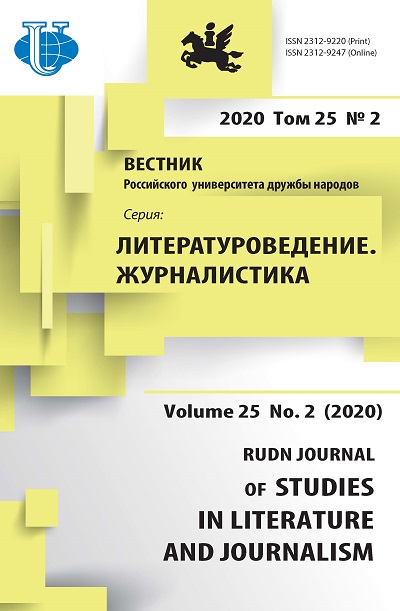Russian television channels on YouTube platform
- Authors: Kruglova L.A.1, Konovaltseva A.O.1
-
Affiliations:
- Lomonosov Moscow State University
- Issue: Vol 25, No 2 (2020)
- Pages: 351-359
- Section: JOURNALISM
- URL: https://journals.rudn.ru/literary-criticism/article/view/24304
- DOI: https://doi.org/10.22363/2312-9220-2020-25-2-351-359
Cite item
Full Text
Abstract
The article is devoted to the analysis of the activities of Russian television channels on the YouTube site. This is one of the stages of a comprehensive study conducted by the Department of Television and Radio Broadcasting, Faculty of Journalism, Lomonosov Moscow State University to understand the processes of transformation of audiovisual content in digital space. At this stage, in 2019, July 27 Russian television channels were selected (including channels in Russian multiplexes), their YouTube accounts were analysed, in terms of the number of subscribers and added videos, as well as the most popular video data channels, the audience’s reaction to them, monetisation, timing, etc. As a result of the preliminary stage of the study, it was found that on most channels there is a “cheat” of views and likes by “bots”, as a result of which the videos do not go to the YouTube trends section and do not become viral.
Keywords
About the authors
Lyudmila A. Kruglova
Lomonosov Moscow State University
Author for correspondence.
Email: abiljo@mail.ru
Ph.D., Assistant Professor of the Department of Television and Radio Broadcasting of Faculty of Journalism
9 Mohovaya St, bldg. 1, Moscow, 125009, Russian FederationAngelina O. Konovaltseva
Lomonosov Moscow State University
Email: missakroman@icloud.com
master of the Department of Television and Radio Broadcasting of Faculty of Journalism
9 Mohovaya St, bldg. 1, Moscow, 125009, Russian FederationReferences
- Dimmick, J.W. (2003). Media competition and coexistence: The theory of Niche. London, Lawrence Erlbaum Associates, Publishers.
- Vartanova, E.L. (2010). O sovremennom ponimanii SMI i zhurnalistiki [On the modern understanding of the media and journalism]. Mediaskop, (1). Retrieved February 16, 2020 from http://www. mediascope.ru
- Balmaeva, S., & Lukina, M. (2016). Kak novye media izmenili zhurnalistiku: 2012–2016 [How new media has changed journalism: 2012–2016]. Ekaterinburg, Gumanitarnyj universitet Publ.
- Amzin, A.A. (2011). Novostnaya internet-zhurnalistika [News online journalism]. Moscow, Aspekt Press.
- Urazova, S.L. (2011). Konvergenciya kak faktor zhiznesposobnosti massmedia v cifrovoj srede: teoreticheskij aspekt [Convergence as a factor in the viability of the media in the digital environment: theoretical aspect]. Vestnik Nizhegorodskogo universiteta imeni N.I. Lobachevskogo, 5(1), 287–293.
- Kul'chickaya, D.Yu., Vartanov, S.A., Dunas, D.V., Salihova, E.A. et al. (2019). Mediapotreblenie molodezhi: specifika metodologii issledovaniya [Media Consumption of Youth: Specificity of Research Methodology]. Mediaskop, (1). Retrieved February 26, 2020 from http://www.mediascope.ru/2529
- Kolomiec, V.P. (2010). Mediasreda i mediapotreblenie v sovremennom rossijskom obshchestve [Media environment and media consumption in modern Russian society]. Sociologiya kommunikacij, (1), 58−66.
- Barker, M., Turnbull, S., & Mathijs, E. (Eds.). (2014). Editorial Introduction: Participations Mk 2. Participations, 11 (1). Retrieved February 26, 2020 from https:// www.participations.org/Volume%2011/Issue%201/contents.htm%20
- Kruglova, L.A. (2019). Mediapotreblenie videokontenta cifrovym pokoleniem [Media Consumption of Video Content by Digital Generation]. Mediaskop, (2). DOI: 10.30547/ mediascope.2.2019.2.
- V'yugina, D.M. (2018). Internet v ezhednevnom mediapotreblenii cifrovogo pokoleniya Rossii [Internet in the daily media consumption of the digital generation of Russia]. Mediaskop, (3). Retrieved February 26, 2020 from http://www.mediascope.ru/2475
- Vartanov, S.A. (2017). Televizionnye izmereniya v epohu Big Data: koncepcii i primery [Television measurements in the era of Big Data: concepts and examples]. Vestn. Mosk. un-ta. Ser. 10. Zhurnalistika, (3), 37–58.
- Lazutova, N.M., & Volkova, I.I. (2013). Eticheskoe i igrovoe v ustanovkah kommunikatorov raznyh pokolenij [Ethical and gaming in the settings of communicators of different generations]. European Social Science Journal, 11–1(38), 285–291.
- Jenkins, H. (2003). Transmedia Storytelling: Moving Characters from Books to Films to Video Games Can Make Them Stronger and More Compelling. MIT Technology Review. Retrieved February 26, 2020 from https://www.technologyreview.com/s/401760/ transmedia-storytelling/
- Stefanone, M.A., Lackaff, D., & Rosen D. (2010). The Relationship between Traditional Mass Media and “Social Media”: Reality Television as a Model for Social Network Site Behavior. Journal of Broadcasting & Electronic Media, 54(3), 508−525. Retrieved March 6, 2020 from http://www.tandfonline.com/doi/pdf/10.1080/08838151.2010. 498851
- Vernik, A.G. (2014). Sozdanie professional'nogo internet-kontenta: rossijskij opyt i sravnitel'nyj analiz YouTube-kanala “Dozhd'” [Creating a professional internet-content: Russian experience and comparative analysis of Youtube channel “Dozhd'”]. Vestnik Chelyabinskogo gosudarstvennogo pedagogicheskogo universiteta, 9–2. Retrieved March 6, 2020 from https://cyberleninka.ru/article/n/sozdanie-professionalnogo-internet-kontentarossiyskiy-opyt-i-sravnitelnyy-analiz-youtube-kanala-dozhd
- Konstatyuk, V.A. (2012). YouTube: zhelanie v media i serijnost' [YouTube: media desire and seriality]. Mezhdunarodnyj zhurnal issledovanij kul'tury, 3(8). Retrieved March 6, 2020 from https://cyberleninka.ru/article/n/YouTube-zhelanie-v-media-i-seriynost
- Kruglova, L.A., & Artes, A.S. (2019). Telekanaly v efire i na YouTube: spetsifika vzaimodeystviya na primere “Rossii K” i ARTE [TV channels on the air and on YouTube: specifics of interaction using the example of “Russia K” and ARTE]. Vestnik Novosibirskogo gosudarstvennogo universiteta. Seriya: Istoriya, filologiya, 18(6), 139–149.
- Berezin, V.M., Volkova, I.I., & Grabelnikov, A.A. (2008). Ekrannaya kommunikatsiya v sovremennom informatsionnom obshchestve [Screen communication in the modern information society]. Moscow, RUDN University Publ.
- Ilchenko, S.N., & Okner, O.A. (2005). Televideniye v epokhu internet [Television in the era of the Internet]. Saint Petersburg.
- Shchepilova, G.G., & Kruglova, L.A. (2018). Telekanaly i social'nye seti: specifika vzaimodejstviya [TV channels and social networks: specifics of interaction]. Vestnik Moskovskogo universiteta. Seriya 10: Zhurnalistika, (3), 3–16.
- Fokin, A.A. (2013). The epoch of internet visuality: YouTube, Instagram, GIF, Coub [The era of Internet visuality: YouTube, Instagram, GIF, Coub]. Chelyabinsk Humanitarian, 2 (23). Retrieved March 6, 2020 from https://cyberleninka.ru/article/n/epohainternet-vizualnosti-YouTube-instagram-gif-coub
- Belyh, A. (February 8, 2018). YouTube vs TV: gde effektivnee prodvigat' vash brend [YouTube vs TV: where it is more effective to promote your brand]. Rusbase. Retrieved March 6, 2020 from https://rb.ru/opinion/youtube-vs-tv/
- Sotnik, N. (September 30, 2016). YouTube protiv TV: kak videoblogery kopayut mogilu televideniyu [YouTube against TV: how video bloggers dig a grave on television]. Afisha Daily. Retrieved March 6, 2020 from https://daily.afisha.ru/brain/3124-YouTubeprotiv-tv-kak-videoblogery-kopayut-mogilu-televideniyu/
















